Papers by Patricia Janssen

PsycEXTRA Dataset, 2005
Objectives: The purpose of this study was to measure the prevalence of household food insecurity ... more Objectives: The purpose of this study was to measure the prevalence of household food insecurity and to determine the association of household food insecurity with covariates related to the physical and social environments as well as the relationship of household food insecurity to preschool children's body mass index and nutritional status indicators. Study Design: Household food insecurity was measured using the USDA Core Food Security Module in a convenience sample of 142 households with children aged 2-5 years in Vancouver in March 2004. Univariate analyses utilized two-sample t-tests, Wilcoxon signed-rank test and Spearman rank correlation. Multivariate logistic regression was used to examine associations among socio-demographic variables, physical and social environmental predictors, children's body mass index, children's serum ferritin, serum zinc and household food insecurity. Results: Half of households were categorized as food secure, 16.2% were categorized as food insecure with anxiety about their food supply, 21.0% as food insecure with few or no hunger indications, 11.9% as moderately food insecure with indications of adult hunger and 0.7% as severely food insecure with high risk of child hunger. After controlling for socio-demographic variables, parents with less access to food of reasonable quality, lower self-rated food preparation skills, fewer cooking appliances, and lower levels of social inclusion were more likely to experience household food insecurity. Children in food insecure households were over twice as likely to have a body mass index over the 85th percentile compared to those in food secure households OR 2.6 (95%CI: 1.02, 6.5). Spearman rank correlation showed a significant association between increasing household food insecurity and increasing body mass index z-score (rho = 0.18, p = 0.04). Median serum zinc levels were significantly lower among children from food insecure households. Study results did not show a correlation between household food insecurity and serum ferritin depletion. Conclusions and Implications: The prevalence of household food insecurity in the present study indicates a need for monitoring of food insecurity among households with children in Canada. The results suggest that the physical and social environments as well as personal/household attributes are associated with household food insecurity. The study provides evidence that food insecurity is associated with sub-optimal nutritional status in young children. Table of Contents ABSTRACT ii TABLE OF CONTENTS iii LIST OF TABLES ix LIST OF FIGURES xi LIST OF ABBREVIATIONS xii ACKNOWLEDGEMENTS xiii CHAPTER 1 INTRODUCTION 1 1. 1 BACKGROUND l 1.2 PURPOSE l 1.3 OBJECTIVES 1 1.4 HYPOTHESES 2 CHAPTER 2 LITERATURE REVIEW 2.1 INTRODUCTION 3 2.2 RISK FACTORS FOR HOUSEHOLD FOOD INSECURITY 2.3 CONSEQUENCES OF HOUSEHOLD FOOD INSECURITY 2.4 PREVALENCE AND SEVERITY OF FOOD INSECURITY AMONG CHILDREN AND FAMILIES 5 2.4.1 Prevalence of Food Insecurity Among Adults 5 2.4.2 Prevalence of Food Insecurity Among Children 6 2.5 SOCIO-DEMOGRAPHIC CHARACTERISTICS OF FOOD INSECURE CANADIANS 2.5.1 Low Income 2.5.2 Age and Lone Parent Status 7 2.5.3 Other Factors 2.6 FOOD INSECURITY AND HEALTH 2.6.1 Relationship between Household Food Security and Child Health 8 2.6.1.1 Physical Health Status 2.6.1.2 Emotional and Behavioural Functioning 2.6.1.3 Academic Outcomes
International Journal of Injury Control and Safety Promotion, Jun 1, 2007
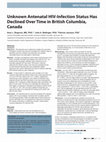
Journal of obstetrics and gynaecology Canada, 2018
Objectives: The objective was to determine whether the proportion of pregnant women with unknown ... more Objectives: The objective was to determine whether the proportion of pregnant women with unknown antenatal HIV-infection status is declining over time in British Columbia (BC) and whether associated factors are amenable to intervention. Methods: Through a retrospective cohort study of all deliveries in the British Columbia Perinatal Data Registry from 2005 to 2011, we examined the association between year of delivery and no recorded antenatal HIV test result. The trend in unknown antenatal HIV-infection status over time was evaluated by the Cochran-Mantel-Haenzsel test and multivariable logistic regression was used to determine the odds of unknown antenatal HIV-infection status by year of delivery. Results: A total of 299 771 deliveries were included; 9.1% had unknown antenatal HIV-infection status with a declining trend from 12.7% to 5.5% from 2005 to 2011 (P < 0.0001). Adjusted for maternal age, parity, gestation, and number of antenatal visits, pregnant women were 64% less likely to not have antenatal HIV testing in 2011 compared to 2005 (adjusted odds ratio [aOR] 0.36; 95% CI 0.34-0.38). The odds of no antenatal HIV testing were 54% higher in multiparous compared to primiparous women (aOR 1.54; 95% CI 1.49-1.58), and each additional antenatal visit reduced the odds of no antenatal HIV testing by 8% (aOR 0.92; 95% CI 0.92-0.93). Conclusion: The declining trend in unknown antenatal HIV-infection status in BC is encouraging. Consistent with Canadian and BC HIV testing guidelines, further strengthening of routine testing at the first antenatal visit in all pregnancies irrespective of previous HIV testing, particularly in multiparous women, could achieve universal pregnancy HIV testing in BC.
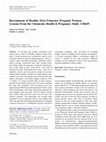
Maternal and Child Health Journal, Jan 6, 2011
To describe and evaluate recruitment techniques used to enroll 152 healthy pregnant women fewer t... more To describe and evaluate recruitment techniques used to enroll 152 healthy pregnant women fewer than 15 weeks gestation into a prospective study of environmental chemical exposure during pregnancy. Posters, a website, online and print advertising, recruitment emails, media coverage, recruitment from clinic waiting rooms, networking within the pregnancy community and presenting a study booth at baby ''trade shows'' were used to advertise the study. Participants had to meet a strict set of eligibility criteria, and were asked to donate two-secondtrimester blood samples, complete two questionnaires, have samples of air, dust, lint and tap water collected from their homes, and donate a cord blood sample at delivery. Over 17 months, 171 women enrolled (49% of initial contacts, and 99% of all eligible women) and 152 women completed the study (89% retention). Total recruitment costs were approximately $400 Cdn per final participant. Posters, study booth presentations and online advertising generated the most inquiries about the study. Word of mouth, referral from another study and direct email were the most costeffective strategies. Not surprisingly, the recruited study population was less ethnically diverse, more affluent and more educated than the background population of pregnant women in Vancouver. A combination of passive and active recruitment techniques were successful for recruiting healthy women in roughly the first trimester of pregnancy (\15 weeks gestation). While a convenience sample of women is suitable for our study questions, additional strategies may be required to recruit a more representative pregnant population in future studies.
Awhonn Lifelines, Oct 1, 2000

Midwifery, Mar 1, 2013
The Early Development Instrument (EDI), a teacher-completed measure of children's school readines... more The Early Development Instrument (EDI), a teacher-completed measure of children's school readiness at entry to Grade 1, was designed to provide communities with an informative, inexpensive and psychometrically sound tool to assess outcomes of early development as reflected in children's school readiness. Its psychometric properties at individual level were evaluated in two studies. Five a priori domains-physical health and well-being, social competence, emotional maturity, language and communication, and cognitive development and general knowledge-were tested in a factor analysis of data on over 16,000 kindergarten children. The factor analyses upheld the first three domains, but revealed the need to develop two new ones, resulting in the final version of the EDI consisting of: physical health and well-being, social competence, emotional maturity, language and cognitive development, communication skills and general knowledge domains. These final domains showed good reliability levels, comparable with other instruments. A separate study (N = 82) demonstrated consistent agreements in parent-teacher, interrater reliabilities, concurrent validity, and convergent validity. These results establish the EDI as a psychometrically adequate indicator of child well-being at school entry. Resume L'instrument de mesure du developpement a la petite enfance a 6te congu afin de fournir un outil approprie, peu couteux et valide sur le plan psychometrique, permettant d'evaluer Ies capacites de 1'enfant a entrer en premiere annee primaire. Les propri^tes psychometriques de l'instrument ont ete evalu^es au cours de deux etudes. Une analyse factorielle menee a partir des donnees recueillies auprfes de 16 000 enfants de maternelle a permis de tester la presence de cinq facteurs theoriques : sant6 physique et bien-etre, competence sociale, maturite affective, langage et communication, developpement co
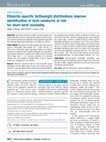
American Journal of Obstetrics and Gynecology, Nov 1, 2013
We aimed to determine whether ethnicity-specific birthweight distributions more accurately identi... more We aimed to determine whether ethnicity-specific birthweight distributions more accurately identify newborns at risk for shortterm neonatal morbidity associated with small for gestational age (SGA) birth than population-based distributions not stratified on ethnicity. STUDY DESIGN: We examined 100,463 singleton term infants born to parents in Washington State between Jan. 1, 2006, and Dec. 31, 2008. Using multivariable logistic regression models, we compared the ability of an ethnicity-specific growth distribution and a populationbased growth distribution to predict which infants were at increased risk for Apgar score <7 at 5 minutes, admission to the neonatal intensive care unit, ventilation, extended length of stay in hospital, hypothermia, hypoglycemia, and infection. RESULTS: Newborns considered SGA by ethnicity-specific weight distributions had the highest rates of each of the adverse outcomes assessed-more than double those of infants only considered SGA by the population-based standards. When controlling for mother's age, parity, body mass index, education, gestational age, mode of delivery, and marital status, newborns considered SGA by ethnicity-specific birthweight distributions were between 2 and 7 times more likely to suffer from the adverse outcomes listed above than infants who were not SGA. In contrast, newborns considered SGA by population-based birthweight distributions alone were at no higher risk of any adverse outcome except hypothermia (adjusted odds ratio, 2.76; 95% confidence interval, 1.68e4.55) and neonatal intensive care unit admission (adjusted odds ratio, 1.40; 95% confidence interval, 1.18e1.67). CONCLUSION: Ethnicity-specific birthweight distributions were significantly better at identifying the infants at higher risk of short-term neonatal morbidity, suggesting that their use could save resources and unnecessary parental anxiety.

Journal of Exposure Science and Environmental Epidemiology, May 14, 2008
Numerous studies suggest that in utero exposures to environmental contaminants are associated wit... more Numerous studies suggest that in utero exposures to environmental contaminants are associated with fetal development, congenital anomalies, learning difficulties or other health impacts later in life. Although location and time-activity data have been used to model exposure to specific contaminants in epidemiological studies, little information is available about time-activity patterns of pregnant women. We measured changes in location-based activity patterns over the course of pregnancy (48-h periods, during two or three trimesters) using a self-reported time-activity log among a nonrandom sample of pregnant women (n=62). We assessed the influence of demographics and personal factors on changes in activity over pregnancy using mixed effects regression models. Increasing weeks of pregnancy was a significant predictor for increased time spent at home (1 h/day increase for each trimester of pregnancy), after adjusting for income (2.6 more h/day at home in lowest income group), work status (3.5 more h/day at home for nonworkers) and other children in the family (1.5 more h/day at home with other children). No other measured activities (time outdoors, time in transit modalities or time in other indoor locations) were related to weeks of pregnancy. As our results indicate that pregnant women tend to spend more time at home during the latter stages of pregnancy, future exposure and epidemiological research should consider the potential increase in home-based exposures (i.e., indoor air pollution or chemicals in the home) late in pregnancy, and increased confidence in exposure proxies based on home locations or characteristics during the same period.
Proceedings of SPIE, Feb 1, 2012
Background: Fetal well-being is determined in large part by how well the placenta is able to supp... more Background: Fetal well-being is determined in large part by how well the placenta is able to supply oxygen and nutrients, but current technology is unable to directly measure how well a placenta functions. Near-infrared spectroscopy (NIRS) utilizes optical methods to measure ...
Journal of Midwifery & Women's Health, Sep 10, 2004
Health are pleased to present abstracts from the 2004 Research Forums podium presentations. The p... more Health are pleased to present abstracts from the 2004 Research Forums podium presentations. The podium presentations were selected in a blinded, peer-reviewed process in the winter of 2004 and presented at the Annual Meeting in New Orleans, LA. Only abstracts of completed research were eligible for publication. The abstracts presented here demonstrate the breadth and quality of research being conducted about midwifery and women's health by midwifery researchers and our colleagues. This column will be an annual feature in JMWH, and we hope that they will provide readers with useful, new knowledge.
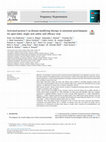
Pregnancy Hypertension, Jul 1, 2018
Preeclampsia is characterized by maternal systemic inflammation and coagulation activation, akin ... more Preeclampsia is characterized by maternal systemic inflammation and coagulation activation, akin to the sepsis syndrome. Recombinant human activated protein C (rhAPC; drotrecogin alfa [activated]) may modify disease progression to safely prolong pregnancies and improve perinatal outcomes. Both maternal and perinatal risks are highest remote from term. Study design: Open-label, single arm safety and efficacy trial of rhAPC in consenting pregnant women with severe early-onset preeclampsia. Disease severity-matched rhAPC-naïve controls were identified from an existing database. An additional six women were recruited as biomarker controls. Main outcome measures: Primary safety outcome: incidence of peripartum bleeding; primary efficacy outcome: duration of pregnancy after enrolment. Results: Twelve (31.6%) of 38 eligible women consented; 3 did not receive the infusion due to staffing. Therefore, 9 women received rhAPC (24 μg/kg/hr for ≤96 h antenatally). No safety issues were identified. There was a marginal prolongation in eligibility-to-delivery intervals for women receiving rhAPC (Mantel-Cox p = 0.052; Gehan-Breslow-Wilcoxon p = 0.049). Compared with both the pre-infusion phase in the rhAPC-treated women themselves and with fullPIERS rhAPC-naïve women, rhAPC was associated with increased urine output during the infusion (6/9 vs 1/9 had urine output > 100 mL/h during the infusion, Fisher's exact p = 0.003). Conclusions: These data support further investigation of APC in women with severe early-onset preeclampsia; recombinant and purified human APC is available. In addition, these data will inform the design and implementation of randomized controlled trials aiming to modify and/or moderate the proinflammatory and proacoagulant state of preeclampsia.

Journal of Clinical Ultrasound, 1999
The invasive nature of vaginal sonography, recently introduced as an improved diagnostic method f... more The invasive nature of vaginal sonography, recently introduced as an improved diagnostic method for imaging the contents of the pregnant uterus, has provoked discussion about patient preference for female sonographers. This study examined whether patients had a gender preference for the sonographer who would conduct such an examination. Over 3 months, a written survey was given to pregnant women to complete anonymously while waiting for their scheduled sonographic examination. The survey covered gender preference for the sonographer and education, ethnicity, and previous experience with the procedure. Surveys were turned in by 1,002 pregnant women. Of the women whose survey responses were analyzed, 62% preferred a female sonographer. The principal reason given for this preference was comfort with the same gender. The majority of respondents were 25-40 years old, married, white, and multiparous. The level of education varied widely. These findings point to a need to seek consumer input when new technology is introduced, to provide women with choices where possible, and to ensure that they have access to information about those choices.
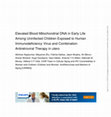
The Journal of Infectious Diseases, Jul 8, 2020
BackgroundCombination antiretroviral therapy (cART) during pregnancy prevents vertical transmissi... more BackgroundCombination antiretroviral therapy (cART) during pregnancy prevents vertical transmission, but many antiretrovirals cross the placenta and several can affect mitochondria. Exposure to maternal human immunodeficiency virus (HIV) and/or cART could have long-term effects on children who are HIV exposed and uninfected (CHEU). Our objective was to compare blood mitochondrial DNA (mtDNA) content in CHEU and children who are HIV unexposed and uninfected (CHUU), at birth and in early life.MethodsWhole-blood mtDNA content at birth and in early life (age 0–3 years) was compared cross-sectionally between CHEU and CHUU. Longitudinal changes in mtDNA content among CHEU was also evaluated.ResultsAt birth, CHEU status and younger gestational age were associated with higher mtDNA content. These remained independently associated with mtDNA content in multivariable analyses, whether considering all infants, or only those born at term. Longitudinally, CHEU mtDNA levels remained unchanged during the first 6 months of life, and gradually declined thereafter. A separate age- and sex-matched cross-sectional analysis (in 214 CHEU and 214 CHUU) illustrates that the difference in mtDNA between the groups remains detectable throughout the first 3 years of life.ConclusionThe persistently elevated blood mtDNA content observed among CHEU represents a long-term effect, possibly resulting from in utero stresses related to maternal HIV and/or cART. The clinical impact of altered mtDNA levels is unclear.
Womens Health Issues, Nov 1, 2000
This was a prospective cohort questionnaire study to compare the loss of ability to work in 62 wo... more This was a prospective cohort questionnaire study to compare the loss of ability to work in 62 women having medical and 69 having surgical abortions. Outcomes included the number of days lost from work outside the home and inside the home before and after the abortion appointment. The mean total loss from work inside the home was 10.1 days for the surgical group and 5.3 days for the medical group (P &lt;.05). The mean total loss from work outside the home was not significant at 4.0 days for the surgical group and 2.5 days for the medical group.
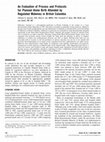
Journal of Midwifery & Women's Health, Mar 4, 2003
Midwifery emerged as a self-regulated profession in British Columbia in the context of a 2-year d... more Midwifery emerged as a self-regulated profession in British Columbia in the context of a 2-year demonstration project beginning in 1998. The project evaluated accountability among midwives, defined as the provision of safe and appropriate care and maintenance of standards of communication set by the College of Midwives of British Columbia. Adherence to protocols was measured by using documentation designed specifically for the Home Birth Demonstration Project. Hospital and transport records for selected clients were reviewed by an expert committee. Outcomes among Home Birth Demonstration Project clients were compared with outcomes among women eligible for home birth but planning to deliver in hospital. Adherence to clinical and communication protocols was 96% or higher. Planned home birth was not associated with an increase in risk but prevalence of adverse outcomes was too low to be studied with precision. Recommendations of an expert review committee have been implemented or are under review. Midwives have demonstrated a high degree of compliance with reporting requirements and protocols. Comparisons of birth outcomes of planned home versus hospital births, while supporting home birth as a choice for women, were limited in scope and require ongoing study. Integration of home birth has been a dynamic process with guidelines and policy continuing to evolve.
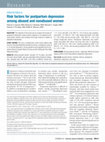
American Journal of Obstetrics and Gynecology, Dec 1, 2012
The objective of the study was to compare risk factors for postpartum depression among women expo... more The objective of the study was to compare risk factors for postpartum depression among women exposed vs not exposed to intimate partner violence and to assess the timing of abuse in relation to postpartum depression. STUDY DESIGN: This was a retrospective cohort study utilizing data from the Canadian Maternity Experiences Survey, a telephone survey at 5-10 months postpartum. Survey questions were adapted from the Canadian Violence Against Women Survey and the Edinburgh Post-Natal Depression Scale. RESULTS: Among abused women, younger (15-19 years), and older (35 years old and older), age was associated with postpartum depression, adjusted odds ratio (aOR, 2.29; 95% confidence interval [CI], 1.17-4.51) and (aOR, 2.33; 95% CI, 1.02-5.34) as was unemployment (aOR, 1.41; 95% CI, 1.06-1.84), foreign birth (aOR, 2.04; 95% CI, 1.35-3.09], and low income (aOR, 1.68; 95% CI, 1.25-2.25) among nonabused women. Postpartum depression was significantly associated with abuse occurring only prior to pregnancy (aOR, 3.28; 95% CI, 1.86-5.81), starting postpartum (aOR, 4.76; 95% CI, 1.41-16.02), and resuming postpartum (aOR, 3.81; 95% CI, 1.22-11.88). CONCLUSION: Among pregnant women, subgroups defined by abuse exposure differ in their risk profile for postpartum depression.
Journal of the American Board of Family Medicine, Jul 1, 2006
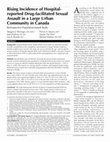
Canadian Journal of Public Health-revue Canadienne De Sante Publique, Nov 1, 2004
Background: Drug-facilitated sexual assault (DFSA) occurs when an individual has been sexually as... more Background: Drug-facilitated sexual assault (DFSA) occurs when an individual has been sexually assaulted due to the surreptitious administration of drug(s) thereby rendering her/him unable to give consent. Our study aim was to calculate the age-and sex-specific annual incidence of hospital-reported DFSA and to determine whether a one-year increase in DFSA observed in 1999 in a pilot study on the same population was a significant and sustained trend. Methods: We identified cases of DFSA by reviewing the sexual assault examination records of all the individuals who presented to a hospital-based sexual assault care referral service in Vancouver, British Columbia during the study time period (January 1, 1993 to May 31, 2002). The annual sex-and age-specific incidence and temporal trends of drugfacilitated sexual assault were examined using population data from the British Columbia Ministry of Health.

Journal of obstetrics and gynaecology Canada, Sep 1, 2003
To compare childbirth outcomes of women prospectively randomized to receive early labour assessme... more To compare childbirth outcomes of women prospectively randomized to receive early labour assessment and support either through a home visit or by telephone triage. Methods: Women in early labour, upon seeking prior telephone advice on whether or not they were ready to be admitted to BC Women's Hospital (as was standard hospital practice), were voluntarily randomized to receive either a home visit by an obstetrical nurse or telephone triage. Results: One hundred seventeen women were randomized to receive home care and 120 to receive telephone triage. Significantly fewer women in the home care group arrived at hospital in the latent stage of labour, compared to women in the telephone triage group (odds ratio [OR], 0.37; 95% confidence interval [CI], 0.19-0.72). Significantly fewer women in the home care group received narcotics (OR, 0.55; 95% CI, 0.32-0.96). Differences observed in use of epidural analgesia (OR, 0.64; 95% CI, 0.36-1.16) were not statistically significant. Newborns in the home care group were significantly less likely to be admitted to a level II observation nursery (OR, 0.13; 95% CI, 0.03-0.60). More women in the home care group would recommend this type of care to a friend (P = 0.00 I). Conclusion: Our findings suggest an association of early labour assessment at home with both admission to hospital in the active phase of labour and reduction in use of analgesia during labour. Early labour support at home was associated with reduced rates of admission of neonates to a level II observation nursery, possibly secondary to reduced exposure to analgesics. Early labour care at home by hospital-based obstetrical nurses is safe and acceptable to women, and may offer advantages in terms of reduced interventions and more vigorous neonates. Resume Objectif : Une etude randomisee prospective visant it com parer les issues d'accouchement de femmes it qui I'on a offert une evaluation precoce et un soutien pendant Ie travail, so it par une visite it domicile, so it par triage telephonique.
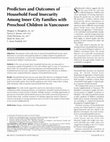
Canadian Journal of Public Health-revue Canadienne De Sante Publique, May 1, 2006
Objectives: The purposes of this study were to measure household food security and to determine i... more Objectives: The purposes of this study were to measure household food security and to determine its association with potential predictor variables related to household and community environments, as well as the relationship between household food insecurity and preschool children's nutritional status. Methods: In this cross-sectional study, household food security was measured in a convenience sample of households (n=142) with children aged 2-5 years in Vancouver in March 2004. We assessed the association between environmental predictors and household food security status, adjusted for household income. Indicators of children's nutrition were compared between categories of household food security. Results: Household food insecurity was associated with indicators of suboptimal health status in preschoolers. After controlling for household income, parents with less access to food of reasonable quality, fewer kitchen appliances and a lower rating of their cooking skills had greater odds of experiencing household food insecurity. La traduction du résumé se trouve à la fin de l'article.





Uploads
Papers by Patricia Janssen